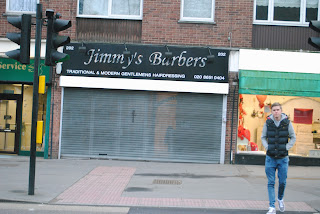At the beginning of this project I had a couple of initial ideas. I started by planning them out and researching artist for inspiration. My main idea so inspired by Julie Cockburn. Julie starts by using both old and newly taken portraits of people and digitally enhances them to distort the face of the person so you can no longer make out who it might be. So from researching Julie Cockburn I then decided that I wanted to do something similar but instead of using people I would go on to use landscape photographs that would contain famous landmarks. I then planned to digitally enhance then landmark in the same way Julie does to the faces. I hoped this would give a great unusual effect that would let the audience/client guess where this location is.
To start this process I took both digital and film photographs as I planned on the shooting plan sheet. However instead of sticking to taking photographs of just landmarks I took photographs of famous shop fronts such as Barclays bank and Blockbusters, places that people would recognise by the colours that have been jumbled about. I also experimented a little further and took a few shots of local places that I would recognise like flats and the local youth club.
From this my idea changed as I came across the work of Quentine Jones and Genadii Berezkin. Both these artists have handmade approaches to their work which is not something I am use to doing so this really appealed to me in such a way that I was able to try something new. I firstly started by producing digital out comes inspired by Geradii but found that to get something similar it would have to be more layered and look a little less like an actual image and more of a collaged piece. I then produced a handmade outcome inspired by Quentine and I really enjoyed the way I could add a pop art twist to the piece.
I continued to work inspired by Quentine and this lead to producing my final outcome. It consists of 3 mixed media collages photocopied in black and white and this placed upon coloured tissue paper. The coloured tissue paper contrast with black and white photocopy and allows it to stand out. This will be presented by simply mounting them onto a large piece of white card.
I think this is really effective yet as simple as it sounds the contrast between colour and black and white is what makes the piece. I think if i could start this project again I probably would change the images I used and maybe add a little more texture to the images so that you would want to touch the pieces. If i was given more time I maybe would have added fabric to some areas of the image and experimented a little more with techniques in hope that I would get a better outcome and grade.
To start this process I took both digital and film photographs as I planned on the shooting plan sheet. However instead of sticking to taking photographs of just landmarks I took photographs of famous shop fronts such as Barclays bank and Blockbusters, places that people would recognise by the colours that have been jumbled about. I also experimented a little further and took a few shots of local places that I would recognise like flats and the local youth club.
From this my idea changed as I came across the work of Quentine Jones and Genadii Berezkin. Both these artists have handmade approaches to their work which is not something I am use to doing so this really appealed to me in such a way that I was able to try something new. I firstly started by producing digital out comes inspired by Geradii but found that to get something similar it would have to be more layered and look a little less like an actual image and more of a collaged piece. I then produced a handmade outcome inspired by Quentine and I really enjoyed the way I could add a pop art twist to the piece.
I continued to work inspired by Quentine and this lead to producing my final outcome. It consists of 3 mixed media collages photocopied in black and white and this placed upon coloured tissue paper. The coloured tissue paper contrast with black and white photocopy and allows it to stand out. This will be presented by simply mounting them onto a large piece of white card.
I think this is really effective yet as simple as it sounds the contrast between colour and black and white is what makes the piece. I think if i could start this project again I probably would change the images I used and maybe add a little more texture to the images so that you would want to touch the pieces. If i was given more time I maybe would have added fabric to some areas of the image and experimented a little more with techniques in hope that I would get a better outcome and grade.



































